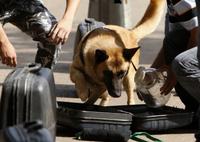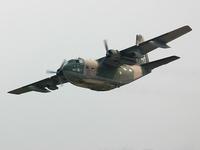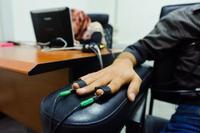-
Faster anthrax detection could speed bioterror response
The fall 2011 anthrax attacks cost $3.2 million in cleanup and decontamination. At the time, no testing system was in place that officials could use to screen the letters. Currently, first responders have tests that can provide a screen for dangerous materials in about 24-48 hours. Now, researchers have developed a new method for anthrax detection that can identify anthrax in only a few hours.
-
-
How dogs detect explosives: New training recommendations

Researchers have helped determine the science behind how canines locate explosives such as Composition C-4 (a plastic explosive used by the U.S. military). The study found the dogs react best to the actual explosive, calling into question the use of products designed to mimic the odor of C-4 for training purposes.
-
-
Hezbollah acknowledges Israel’s Monday air strike
Hezbollah, after initially denying that any of its forces were attacks Monday night, earlier today (Wednesday) admitted that Israel carried out an airstrike targeting the militia’s positions in Lebanon near the border with Syria. Hezbollah’s statement said the air strike caused damage but no casualties. A senior Israeli security official told reporters that the missiles destroyed in the attack could carry warheads heavier and more dangerous than almost all of the tens of thousands of missiles and rockets Hezbollah now has in its arsenal.
-
-
Countering counterfeit electronic components
Used and non-authentic counterfeit electronic components are widespread throughout the defense supply chain; over the past two years alone, more than one million suspect parts have been associated with known supply chain compromises. In the military, a malfunction of a single part could lead to system failures that can put soldier lives and missions at risk. A new DARPA program seeks tool that authenticates electronic components at any step of the supply chain.
-
-
Exposure to IED blasts increases risk of long-term health consequences
Blasts are the leading cause of death and injury on the battlefield, accounting for about 75 percent of all combat-related injuries in U.S. military personnel. U.S. soldiers exposed to blasts while deployed in Iraq and Afghanistan have an increased risk of developing adverse health outcomes over the long term, such as post-traumatic stress disorder (PTSD) and, in certain cases of traumatic brain injury (TBI), growth hormone deficiency, and persistent post-concussive symptoms including headaches, says a new report.
-
-
Israeli jets attack Syrian weapons convoys in Hezbollah-held area in Lebanon

For the second time this year. Israeli jets attacked targets on the border between Lebanon and Syria on Monday night as part of an ongoing campaign to prevent the transfer of advanced weapon systems from the Syrian military to Hezbollah. In 2013, the Israel Air Force (IAF) attacked military bases and arms depots inside Syria on six occasions — 30 January, 3 May, 5 May, 5 July, 18 October, and 30 October. The first attack in 2014 took place on 26 January. The previous seven air strikes were on targets inside Syria, but last Sunday attack was on Syrian military convoys just inside Lebanon, in Hezbollah-controlled areas near the Lebanon-Syria border.
-
-
Cost of plutonium disposal facility skyrockets
The Mixed Oxide (MOX) nuclear fuel factory at the Savannah River Site in South Carolina, being built to help dispose of cold war-era weapon-grade plutonium, would cost up to $30 billion in addition to the $4 billion spent on construction so far. The staggering cost overruns have led many to call for a new, less expensive solution. Matthew Bunn, a former Clinton White House official who helped develop the plutonium disposal program, agrees that the cost of the MOX factory is excessive. “The things we’re trying to accomplish aren’t worth that amount of money,” he said.
-
-
After failing 5 February deadline, Syria wants 100-day extension to remove chemicals
After missing the 5 February deadline to have all its chemical weapons removed from its territory, Syria has submitted a new 100-day plan for their removal. The international group monitoring the operation says the completion of the removal can be accomplished in less time than that. The Organization for the Prohibition of Chemical Weapons (OPCW) executive committee met on Friday in The Hague to discuss the joint OPCW and UN mission at a time when there is a growing international frustration with Syria over its failure to live up to its commitments.
-
-
Aircraft used in Vietnam source of postwar Agent Orange contamination in U.S.

During the Vietnam War, in an operation called Operation Ranch Hand, approximately twenty million gallons of herbicides, including around 10.5 million gallons of dioxin-contaminated Agent Orange, were sprayed by about thirty-four C-123 aircraft. These aircraft were subsequently returned to the United States and were used by Air Force reserve units between 1971 and 1982 for transport operations. Air Force reservists who flew these planes were exposed greater levels of dioxin than previously acknowledged.
-
-
IAEA: Iran's stockpile of 20% enriched uranium shrunk under interim nuclear agreement
The International Atomic Energy Agency (IAEA) reports in its quarterly inspections assessment that the quantity of 20 percent enriched uranium in Iran’s hands has been reduced since last November, when the world’s six powers (P5+1) and Iran have reached an interim agreement on Iran’s nuclear activities. Iran now has 354 pounds of the material — or about one-fifth less than what it had in November. With the right type of centrifuges, it is quicker to enrich uranium from 20 percent to weapon-grade 90 percent than it is to enrich uranium from 1 or 2 percent to 20 percent, so that the smaller the amount of 20 percent uranium a country has, the longer the “breakout” time — the time it would take a country to assemble a nuclear bomb once a decision to do so has been made.
-
-
Secure Communities triggers deportation of undocumented immigrants with no criminal records
The U.S. Immigration and Customs Enforcement’s (ICE) Secure Communitiesprogram sends fingerprint data from local law enforcement and the Federal Bureau of Investigationto immigration officers to identify and deport illegal immigrants who commit major crimes. The program has expanded from fourteen jurisdictions in 2008 to more than 3,000 today. Immigration advocates say that the program’s emphasis on identifying and deporting undocumented immigrants who have committed crimes in the United States notwithstanding, it has also triggered the deportation of 5,964 undocumented immigrants with no criminal records.
-
-
Building a lie detector for social media

In our digital age, rumors — both true and false — spread fast, often with far-reaching consequences. The ability quickly to verify information spread on the Internet and track its provenance would enable governments, emergency services, health agencies, and the private sector to respond more effectively.
-
-
Operations at a New Mexico nuclear waste repository suspended because of leaks
Operations at the Waste Isolation Pilot Plant, or WIPP, a New Mexico burial site for military nuclear waste, were suspended for the fourth day, the Department of Energy said, after sensors picked up radiation leaks inside salt tunnels where the radioactive material is entombed.Officials said no radiation escaped to the surface.This is the second time this month the facility had to suspend operations. Earlier this month operations were halted after a truck caught fire in an underground tunnel.
-
-
Sandia Lab leading multidisciplinary effort to counter WMD
Threats of terrorism and weapons of mass destruction do not seem as imminent today as they did after the 9/11 attacks, but Jill Hruby, vice president of International, Homeland, and Nuclear Security at Sandia Labs, says that scientists, industry, and universities working on technological solutions to national security challenges must anticipate what could come next. Speaking at AAAS annual meeting, Hruby said that in an environment of lower public interest — due, in part, to the success of early efforts to combat terrorism that resulted in fewer major incidents in recent years — continued collaboration between national security laboratories, academia, and industry is needed.
-
-
Identifying, thwarting insider threats before they do damage
Researchers argue that one way to identify and predict potential insider threats even before these individuals begin to do damage like stealing and leaking sensitive information, is by using Big Data to monitor changes in behavior patterns. Researchers at PARC, for example, found that individuals who exhibit sudden decrease in participation in group activity, whether in a game like World of Warcraft or corporate e-mail communications, are likely to withdraw from the organization. A withdrawal represents dissatisfaction with the organization, a common trait of individuals who are likely to engage in insider security breaches.
-
More headlines
The long view
Factories First: Winning the Drone War Before It Starts
Wars are won by factories before they are won on the battlefield,Martin C. Feldmann writes, noting that the United States lacks the manufacturing depth for the coming drone age. Rectifying this situation “will take far more than procurement tweaks,” Feldmann writes. “It demands a national-level, wartime-scale industrial mobilization.”
How Male Grievance Fuels Radicalization and Extremist Violence
Social extremism is evolving in reach and form. While traditional racial supremacy ideologies remain, contemporary movements are now often fueled by something more personal and emotionally resonant: male grievance.
The Surprising Reasons Floods and Other Disasters Are Deadlier at Night
It’s not just that it’s dark and people are asleep. Urban sprawl, confirmation bias, and other factors can play a role.
Why Flash Flood Warnings Will Continue to Go Unheeded
Experts say local education and community support are key to conveying risk.
